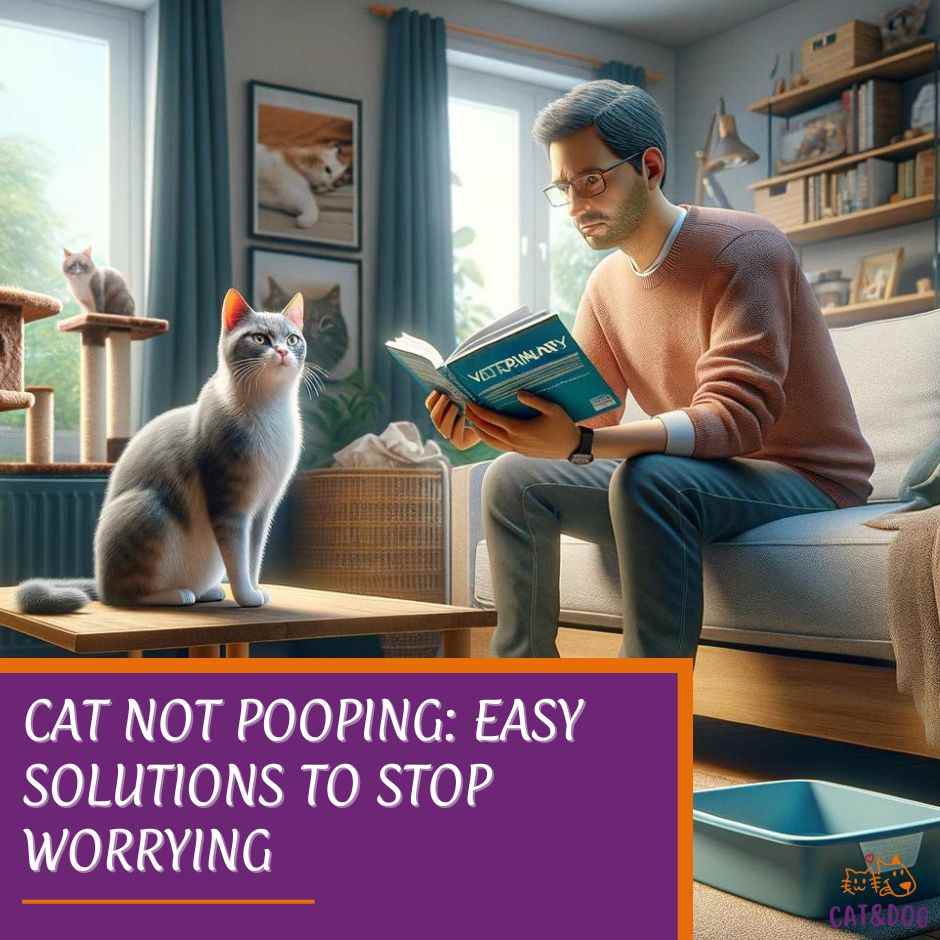When you notice your cat hasn’t been using the litter box for bowel movements, it’s natural to feel a bit worried.
Cats are known for their impeccable grooming habits, so when something as routine as pooping goes awry, it’s a red flag.
If your cat not pooping in a while, you might be dealing with a case of constipation, a common but uncomfortable issue in feline companions. (1)
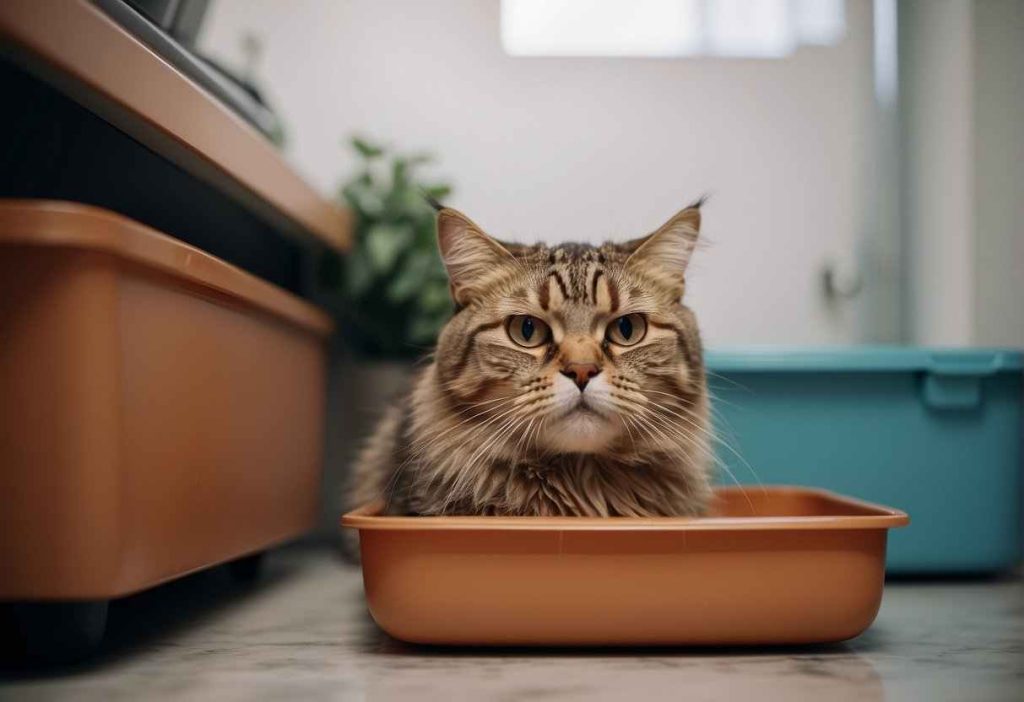
You might be wondering what’s causing this problem and how you can help your cat feel better.
After all, you’re searching for not just any information, but reliable guidance that can offer immediate relief and prevent future issues.
That’s why this article dives into the symptoms to watch for, the potential causes behind your cat’s discomfort, and the various treatment options available, ranging from immediate interventions to long-term preventative strategies.
Rest assured, by the end of this read, you’ll have a solid grasp of when to take a trip to the vet, what to expect, and how to manage your cat’s digestive health.
Don’t forget, that while it’s essential to act swiftly, it’s just as important to stay informed. So let’s get to the bottom of this and help your kitty get back to feeling their best.
Key Takeaways
- Cat constipation is a serious concern and should be addressed promptly.
- Identifying symptoms and understanding causes are crucial for effective treatment.
- Professional advice and long-term care offer the best outcomes for constipated cats.
Cat Not Pooping: Recognizing the Symptoms of Constipation
Physical Indicators:
- Infrequent or no bowel movements: It’s concerning if more than two days go by without any sign of poop in the litter.
- Dry, hard stools: If the deposits look more like pebbles than the usual fare, that’s a red flag. (2)
- Straining or discomfort in the litter box: Does your cat seem to be putting in a lot of effort for very little reward?
- Bloated abdomen: Gentle palpation might reveal a hard, distended belly.
| Behavioral Changes | Significance |
|---|---|
| Hiding/less social | Cats in discomfort may withdraw and hide. |
| Decreased appetite | A backed-up system often reduces the desire to eat. |
| Lethargy | A cat not feeling their best might lack energy. |
Your cat’s demeanor outside the litter box might also tip you off. Have they become more of a recluse lately, avoiding those cuddle sessions they used to love?
And how about their appetite—are they turning their nose up at food they’d usually gobble down?
Remember, you know your cat best, and picking up on these subtle shifts in their behavior and toilet habits can be key to early detection and treatment.
So keep an eye out and if you spot these signs, a vet visit might be in order.
They’ll be able to confirm if your kitty’s plumbing is indeed backed up and provide the right course of action to get them feeling purr-fect again!
Immediate Relief Measures for Constipated Cats
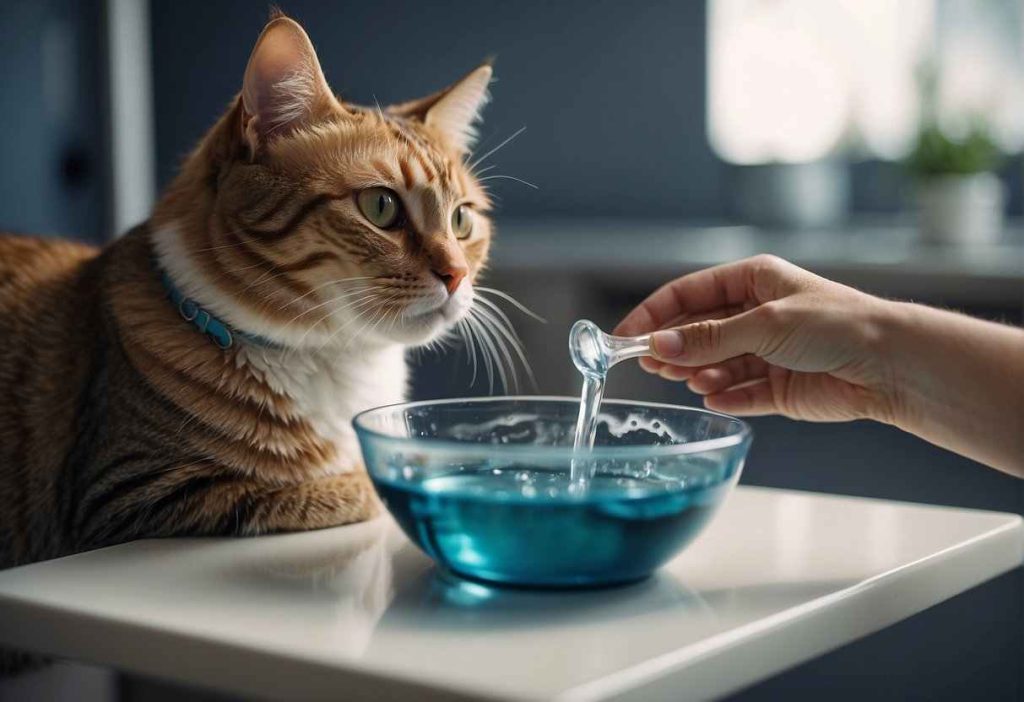
At-Home Remedies
- Water: Ensure your cat is hydrated. More water in their system can help soften stool. Try adding water to dry food or switch to a canned diet temporarily. (3)
- Fiber: A teaspoon of pumpkin puree (not pie filling) is a high-fiber food that can get things moving. Remember to use plain pumpkin. (4)
- Gentle Massage: A soothing belly rub can stimulate your cat’s bowel movements.
- Exercise: Encourage some playful activity to help stimulate digestion. (5)
When to Use Over-the-Counter Options
- Laxatives: Only use cat-specific laxatives. Miralax is a common recommendation, but the dosage is crucial, so don’t guess. A 1/4 teaspoon mixed-in food could start, but talk with your vet. (6)
- Stool Softeners: There are over-the-counter options specifically designed for pets. Again, consult your vet before administration.
Note: Consult your veterinarian before trying any over-the-counter options. They will advise the safest and most appropriate remedy.
If your cat’s constipation persists, or you notice other symptoms like lethargy or loss of appetite, it’s time to visit the vet.
Prompt vet care can prevent constipation from leading to more severe health issues. Keep an eye on your furry companion; they’ll thank you for it.
Understanding the Causes Behind Cat Constipation
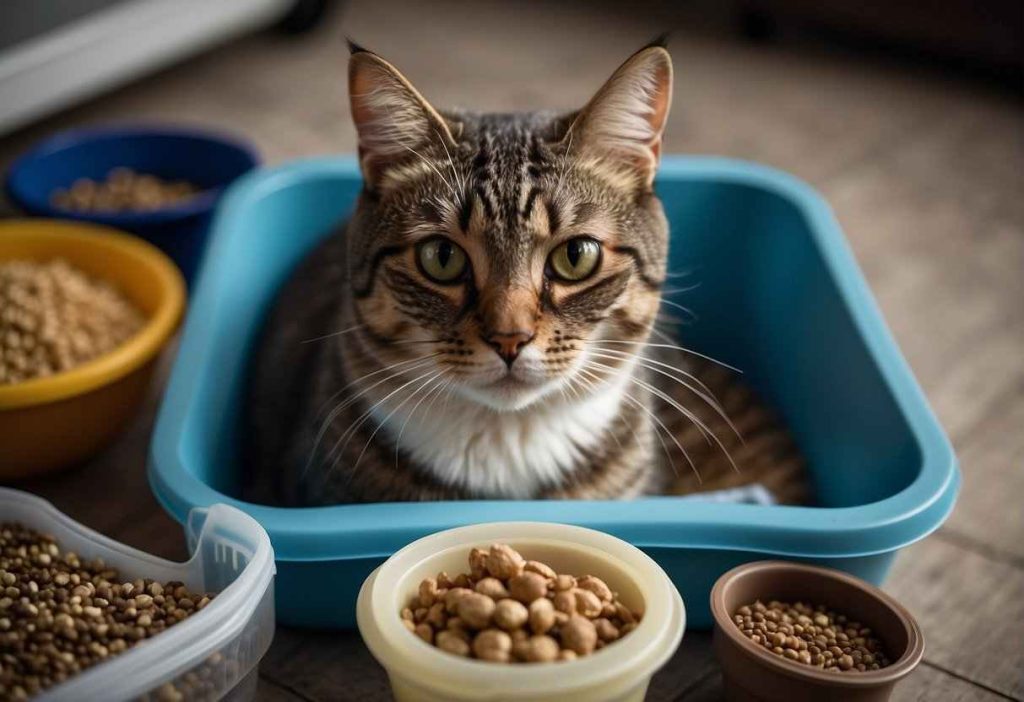
Common Dietary and Environmental Causes:
- Diet: It’s no joke that what goes in must come out, right? But if your cat’s diet is low in fiber or they’re not eating much at all, that could be a roadblock to success in the litter box. Have you checked their menu lately? (7)
- Hydration: Cats can be as picky about drinking water as they are with food. If your whiskered pal is not drinking enough, their digestive system might be like a desert—a little too dry for things to move smoothly.
- Environmental Stress: Cats, like people, can get stressed by changes in their environment or routine. Ever had a hard time going when stressed or in a new place? Cats are no different. (8)
Health Conditions Leading to Constipation:
- Obesity: Carrying extra weight can make it difficult for a cat to do their business, just like it would for you after a big meal. It can squeeze their internal space just enough to make things…complicated.
- Medical Conditions: Kitty constipation can be a symptom of something more serious, like kidney issues or hyperthyroidism. It’s like your body sending you a text message that something’s off.
Remember, I’m not a vet, but if your cat is having more than a few off days, a professional check-up is essential. It’s much more comforting to err on the side of caution, isn’t it?
Keep an eye on their habits, and let’s make sure their next “deposit” is a smooth transaction!
When to See a Vet and What to Expect
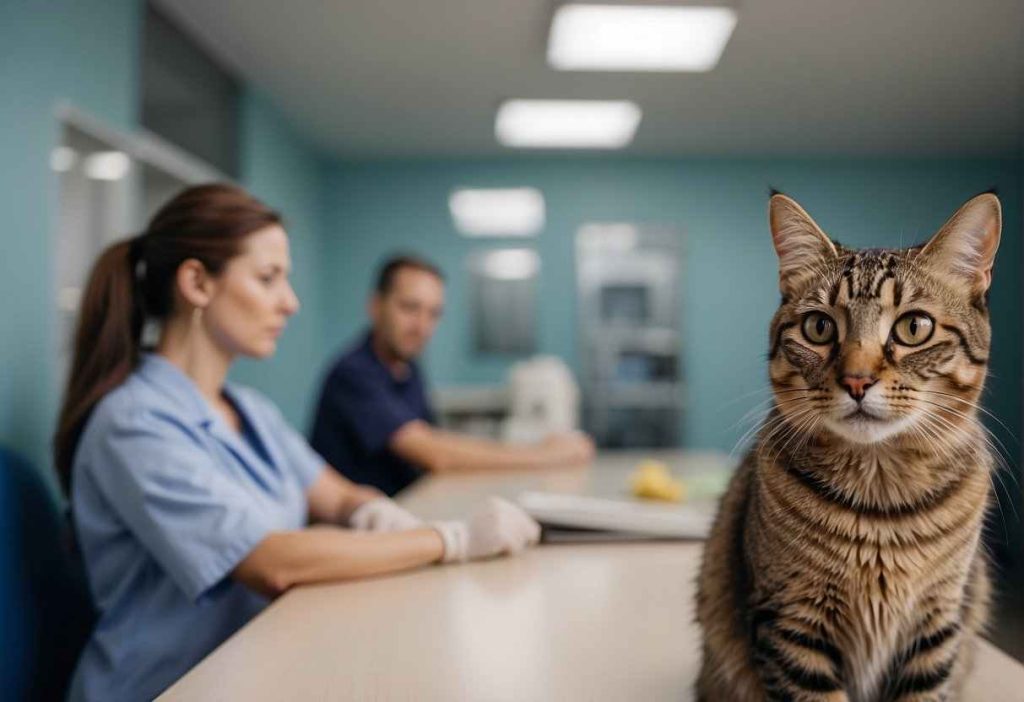
Recognizing When Professional Help is Needed
- Duration: If your cat hasn’t had a bowel movement in more than two days, it’s getting serious.
- Behavior Changes: Is your feline looking more sluggish or hiding more than usual? Time to pay attention!
- Straining: If you notice your cat straining with no result or crying out in the litter box, these are red flags.
- Vomiting or Lack of Appetite: Unusual vomiting or a dip in hunger? Better be safe and consult the vet.
The Veterinary Diagnosis Process
- Initial Conversation: Be ready to discuss your cat’s medical history and the nitty-gritty details of their symptoms.
- Physical Exam: The vet will likely start with a thorough physical examination.
- Possible Tests:
- X-rays: To peek inside and rule out blockages.
- Blood Tests: Checking overall health and organ function.
- Abdominal Ultrasound: A closer look at the intestines and other internal components.
- Treatment Discussion: Depending on the findings, treatments could range from medication to dietary changes, or in more serious cases, surgery.
Remember, you know your cat best, and if you sense that something is off, trust your instincts and schedule that vet appointment. Your furry friend will thank you for it!
Long-term Management and Preventive Strategies
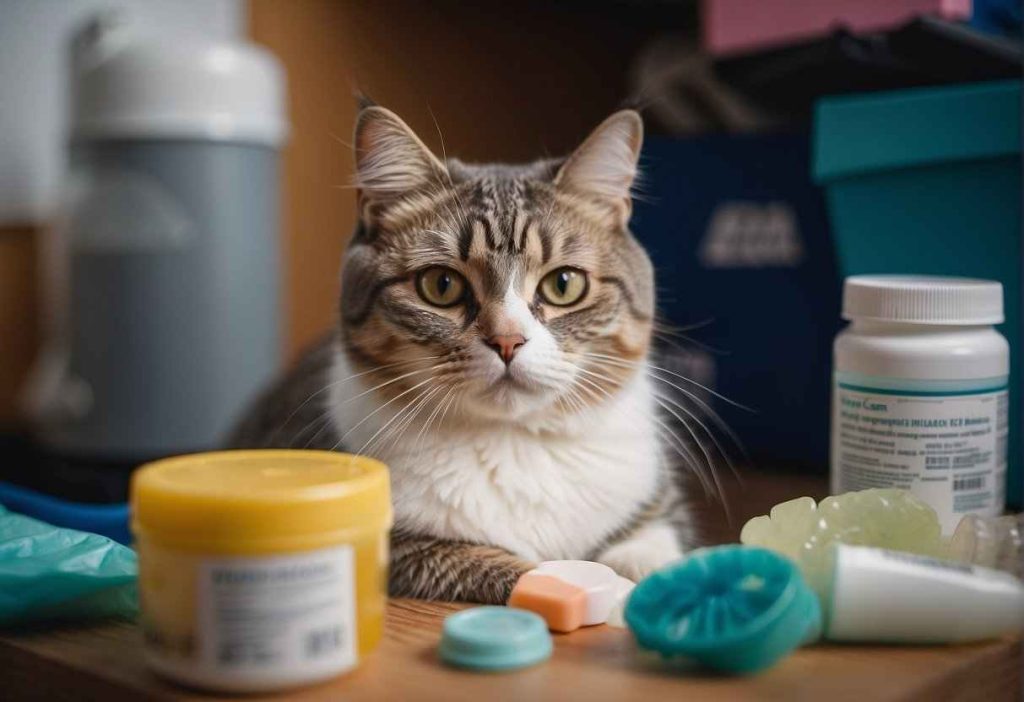
Dietary Management for Health
Well, your furry friend’s diet often holds the key. Let’s focus on what you can serve up to help:
- Fiber: Who knew your cat’s menu might need a fiber boost? Just like us, cats can benefit from an adequate amount of fiber. Aim for a balanced diet that includes both soluble and insoluble fibers. Not too much though – it’s a delicate balance!
- Moisture Content: Cats aren’t big drinkers, so their food should help with hydration. Wet food can be a game-changer, providing both nutrients and much-needed moisture. Dry food fans? Make sure there’s always water on the side.
Importance of Exercise and Enrichment
Routine is comfy, but have you tried a game of laser chase with your cat recently? Regular exercise isn’t just for keeping fit; it helps everything… flow. Here’s a couple of playful nudges:
- Engage your cat in daily play sessions – think lasers, feather wands, or even a cardboard box can do the trick!
- Offer a stimulating environment with scratch posts, window views, and hideouts.
Need a statistic to be convinced? Cats are less likely to have litter box issues when they have an interactive lifestyle. No numbers are needed to know a happy cat is a healthy cat!
Remember, providing an entertaining and active environment can work wonders for your cat’s digestion. No more cat constipation on your watch!
Advanced Treatment Options for Chronic Issues
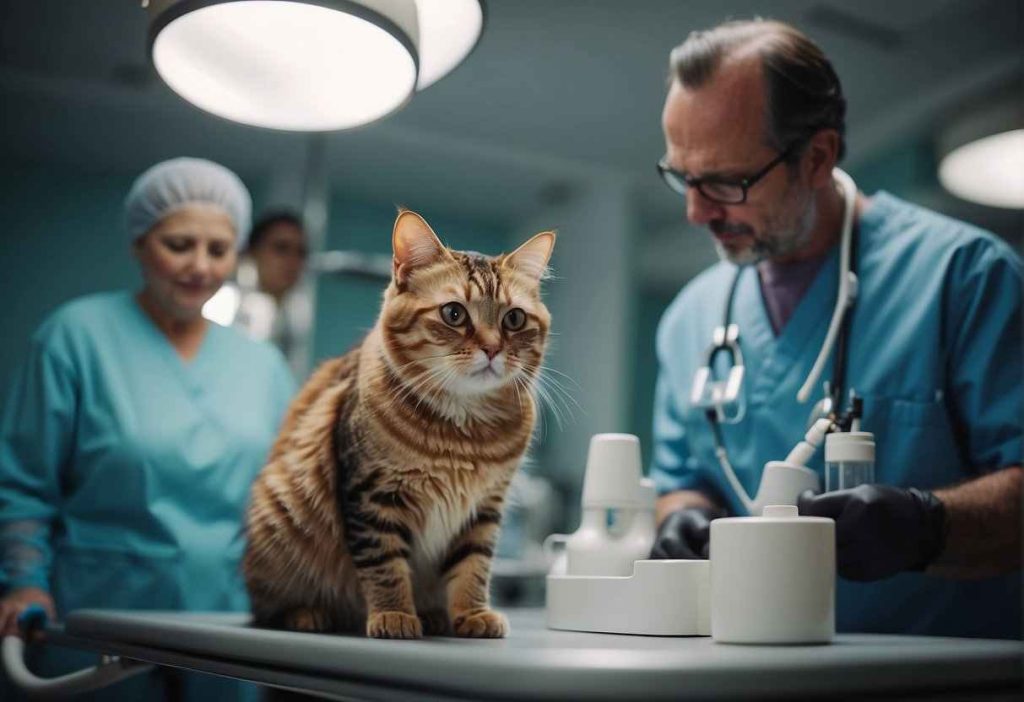
Medications:
- Laxatives: Just like humans, cats can benefit from laxatives, but it’s crucial to use ones specifically safe for them.
- Stool softeners: These can ease the strain and help your kitty pass their stool more comfortably.
Enemas:
- Veterinary Enemas: These should always be performed by a professional, so please don’t try this at home!
Surgery:
- Subtotal Colectomy: For severe cases, surgery might be the best bet, albeit it’s seen as a last resort.
Remember! These treatments should be personalized to your cat’s unique situation, taking into account age, breed, and overall health. Here’s a quick reference:
| Treatment Type | When to Consider | Note |
|---|---|---|
| Medications | Persistent issue after dietary changes | Vet prescribed only |
| Enemas | Immediate relief needed | Professional administration |
| Surgery | Chronic conditions without relief | Last resort |
Engaging with your vet is key; they’re like the detective solving this poopy puzzle! They’ll help you craft the perfect game plan for your cat’s needs.
While no two kitties are the same, with a vet’s wisdom, each step forward is a paw in the right direction. And hey, you’ll be a purr-fect pet parent for tackling this head-on!
Emergency Situations: Recognizing and Reacting
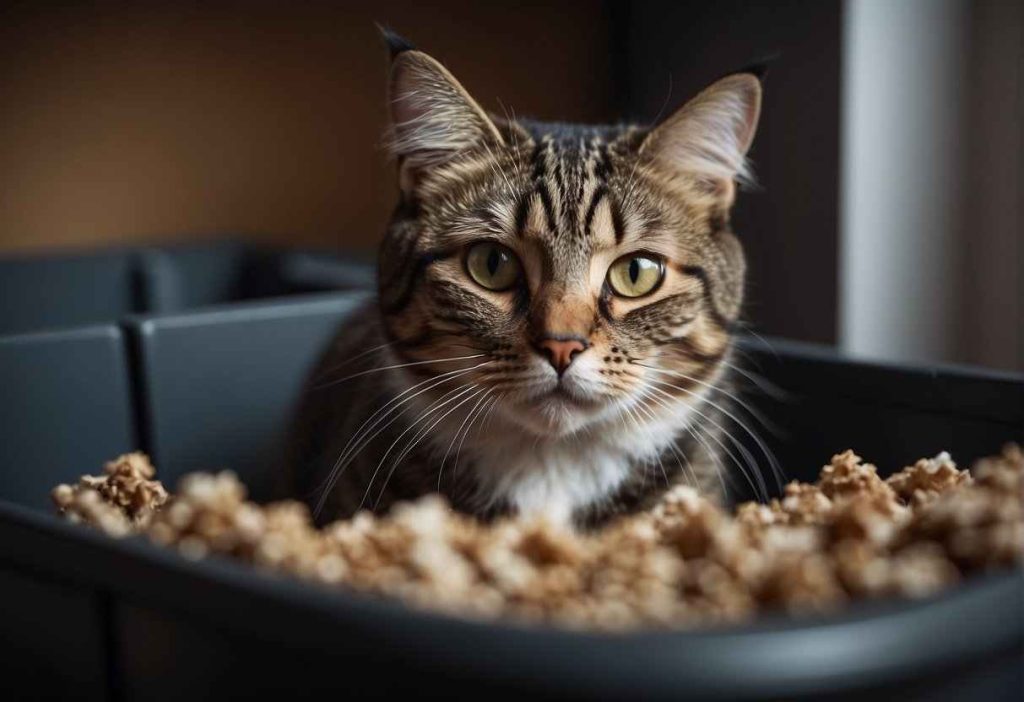
Signs of a Constipation Emergency:
- Persistent Straining: Is your furball trying to go with no success? Regular unsuccessful trips to the litter box could signal trouble.
- Discomfort or Pain: Does your cat cry out or resist touching near their lower abdomen? It’s a clear cry for help.
- Vomiting or Lethargy: Is your kitty more listless than lazy? Combined with vomiting, this is a red flag.
If you see these symptoms, it’s time to act. But what to do?
Immediate Steps:
- Keep Calm: Your cat needs you composed.
- Prepare a Carrier: A cozy and secure carry case can ease a stressful journey.
- Contact a Vet: Ring your veterinarian or the nearest emergency clinic and explain the symptoms.
- Safe Transport: Ensure your cat is comfortable for the ride, avoiding any jostling.
Remember, a constipation crisis in cats isn’t for the faint-hearted, so swift action and professional guidance can make all the difference.
Ready for a quick dash to the vet? Your whiskered companion’s health may depend on it!
Engaging with the Community and Professional Insights

Forums and Community Engagement
Have you ever gone to a forum and suddenly felt less alone? That’s the magic of sharing with a community. When your cat isn’t pooping, these platforms are treasure troves of support:
- Cat Care Forums: Platforms like TheCatSite.com
- Social Media Groups: Facebook groups dedicated to pet health
- Reddit Threads: Search for subreddits where cat owners discuss similar issues
Engaging in these spaces allows you to hear from others who’ve stood in your shoes— worried pet parents just like you.
They might have suggestions you haven’t thought of, from diet changes to exercises that encourage bowel movements.
Professional Insights
Nothing beats a success story, especially when it comes from trustworthy sources. Did you know that vets often share their insights in interviews or online articles?
A few golden nuggets you might discover include:
- Frequency of bowel movements to expect
- Dietary recommendations
- When to seek professional help
Success stories shine light at the end of the tunnel. Imagine reading about Oliver, a tabby who overcame constipation thanks to a diet overhaul.
Or Bella, whose regular vet visits caught an underlying condition in time. These anecdotes not only provide hope but practical steps you might take.
Remember, each cat is unique. For every tale of triumph, there’s a bevy of information specific to your feline friend. When in doubt, your vet is the best go-to source for professional advice tailored to your cat’s needs.
Quick Recap
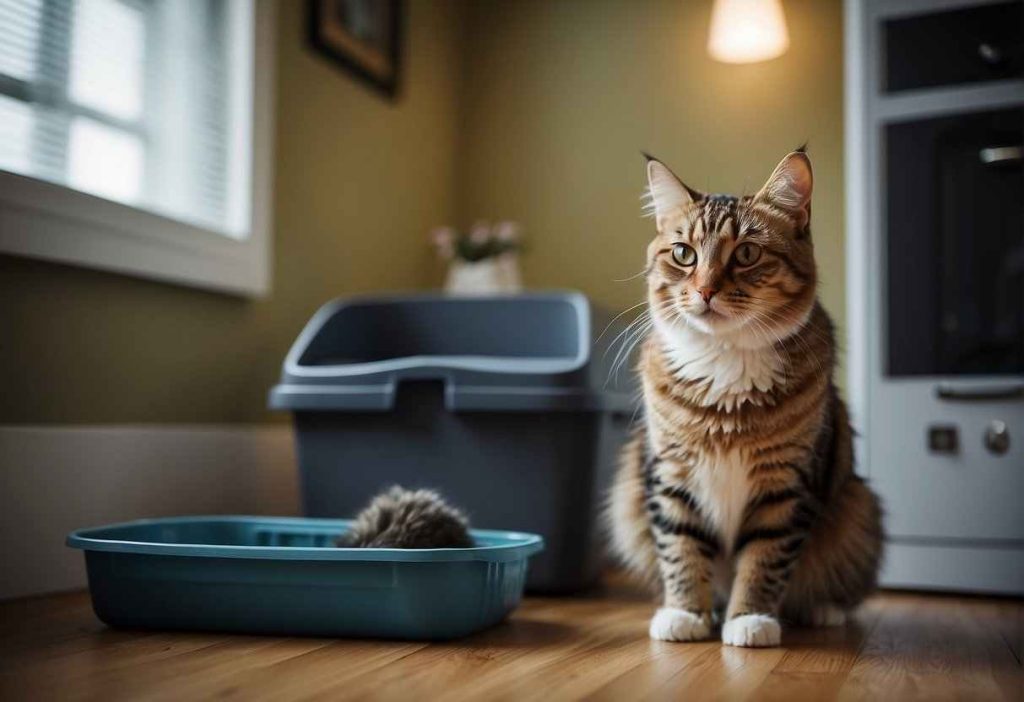
Symptoms to Watch For:
- Is your cat straining in the litter box?
- Have you noticed a lack of poop?
These might be signs your furry friend is constipated.
Seeking Help:
- If symptoms persist, a vet visit is crucial.
- Remember, the earlier, the better to prevent complications!
Preventive Measures:
- Keep your cat hydrated. A water fountain can entice them to drink more.
- A high-fiber diet could be beneficial. Have you tried adding pumpkin to their meals?
Did you know that regular exercise can help keep things moving smoothly?
Proactive Care:
- Consistent litter box cleaning encourages use and helps you monitor habits.
- A stress-free environment is key. Have you considered cat trees or toys?
Partnership with Your Vet:
- Vets can offer personalized advice and treatment plans.
- Regular check-ups ensure your cat’s health stays on track.
Now, with these insights, you’re set to ensure your kitty’s tummy troubles are short-lived. Don’t forget to team up with your vet for a happy, healthy cat!
Frequently Asked Questions
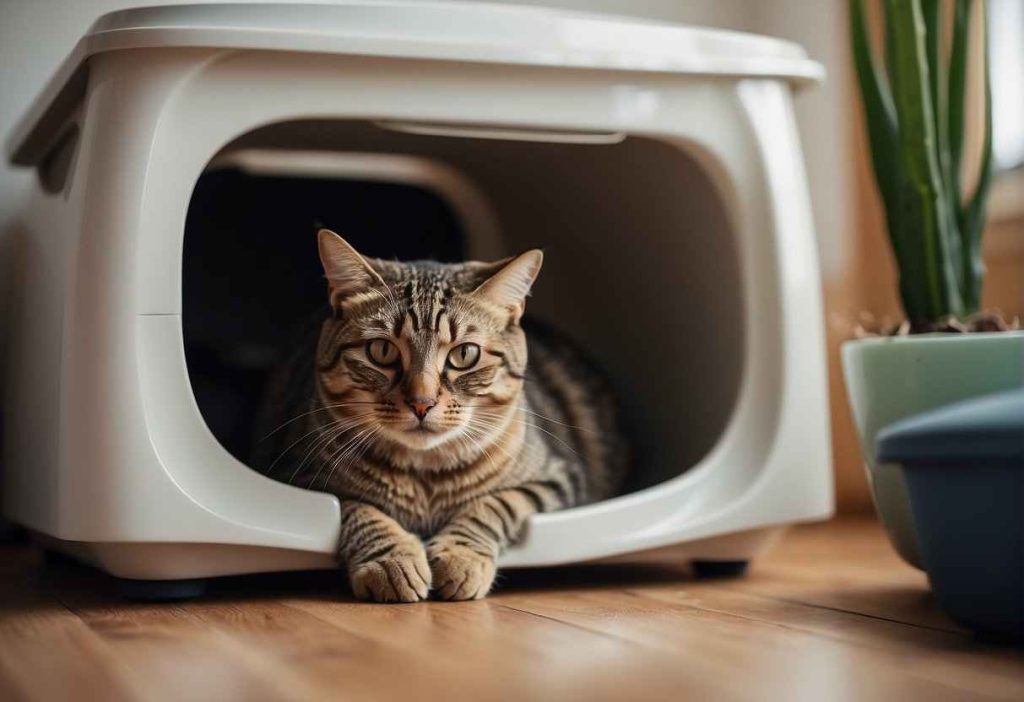
Navigating through the litter box blues, you might wonder how to spot and fix the pooping predicament for your feline friend. You’re not alone in this!
Let’s sort through some common queries regarding your cat’s digestive distress.
What are the first signs of constipation in cats?
The early red flags for constipation in cats include less frequent trips to the litter box, hard and dry stools, or straining without producing much.
You might notice your cat is uncomfortably grooming their rear or showing signs of restlessness and discomfort.
Can a change in diet quickly resolve constipation?
Yes, tweaking your cat’s diet can help. Boosting fiber intake through pumpkin or specially formulated cat foods can work wonders.
However, expect it to take a few days for your cat’s digestive system to adjust and get back on track.
My cat isn’t pooping but seems to be fine otherwise—should I be concerned?
Even if your cat appears normal, a lack of bowel movements for more than 48 hours can signal an issue.
Keeping an eye out for a routine is key since prolonged constipation could lead to more severe consequences.
How often should a healthy cat defecate?
Most healthy cats will defecate once per day, but anywhere from every other day to twice a day can be normal too. Monitoring your cat’s usual habits will help you spot any changes more swiftly.
What home remedies are safe for treating cat constipation?
Safe home remedies for easing your cat’s constipation include gentle belly massages, encouraging hydration, adding canned pumpkin or a small amount of milk to the diet, and providing wet food to increase moisture intake.
How can I tell if my cat’s constipation is due to a serious health issue?
Persistent symptoms that don’t resolve with simple dietary changes or more severe signs like vomiting, lethargy, and a distended abdomen should prompt a vet visit.
Timely professional assessment ensures that any serious underlying issues are not missed.
Can over-the-counter laxatives designed for humans be used for cats?
Never give your cat human laxatives without a vet’s prescription, as they can be dangerous.
Always consult your vet for specific medication suited to your cat’s needs, ensuring their safety and health.
- Online Gambling Establishments Accepting Paypal: A Comprehensive Overview for Gamblers - July 26, 2025
- Leading Mobile Casino Sites: The Ultimate Overview for Online Gambling on the move - July 25, 2025
- Gambling Establishments That Approve PayPal: A Safe and Convenient Choice for Online Gaming - July 25, 2025

